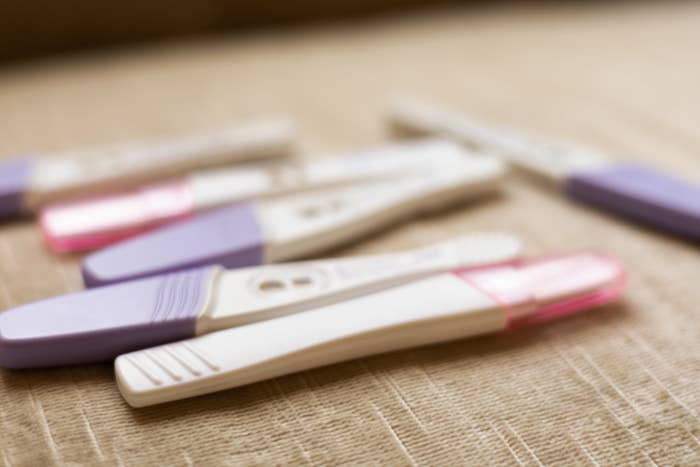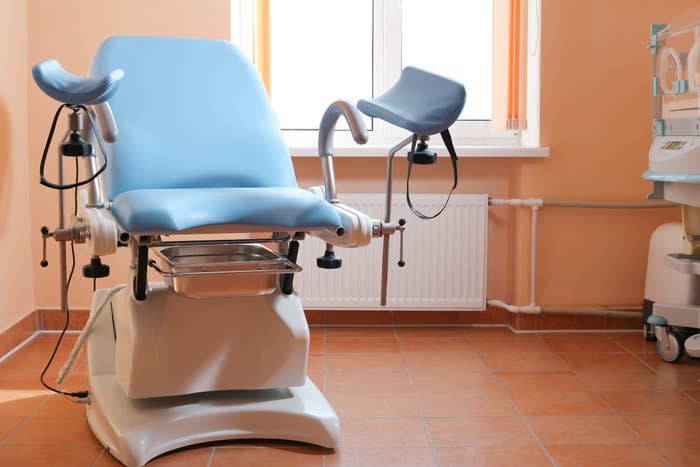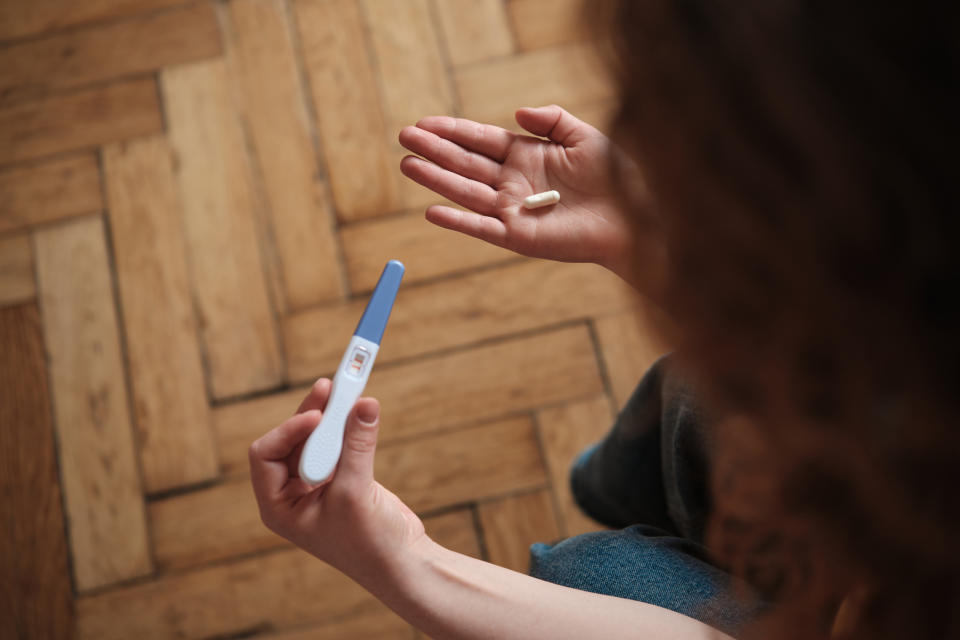I Had An Abortion In My 40s. I'll Never Forget The Shocking Thing The Doctor Said To Me.

I never would have guessed that my first abortion would be when I was in my 40s, married, and a parent already. But that’s the situation I was in when my pregnancy test came back positive in the first July of the COVID-19 pandemic.
Initially, I thought I had COVID — or just anxiety from helicopters flying over Brooklyn nonstop. But when my period was late and then light after it finally arrived, I decided I was probably in perimenopause.
It wasn’t until I spit out a glass of wine I was nursing that I finally knew. The only other time that alcohol had tasted like poison was when I was pregnant six years before.
So, I took a pregnancy test. Then another — and another. (A year later, when we were finally able to administer weekly COVID tests ourselves, I would think about how similar they looked to those for pregnancy. But I wondered why the indicator for COVID was just two straight lines, while the indicators on my pregnancy tests were plus signs — a silent judgment.)
My husband was excited when he found out the news, which made me feel worse, since I only felt panic. I was 41, and I had just come out of three months of remote schooling with my 6-year-old daughter. And then there was work. I had started my own business — a path I took after being pushed out of my previous job at a tech company because I was a mother. Whereas the flexibility and independence I had now were more desirable, it also became impossible for me to take any kind of maternity leave without losing massive amounts of income.
But weren’t these selfish reasons to be in doubt? Weren’t there people raising kids with much less?
Still unsure about what to do, I made an appointment with an OB-GYN. The one who had delivered my daughter moved from downtown to the Upper West Side, and there was no way I was taking the subway to her office while COVID was still spreading. Instead, I found a local place that I could walk to. It was my first visit to a doctor since the pandemic began, and I was scared. I double-masked. I wore gloves.
After arriving, I changed into a hospital gown from the nurse and waited alone in the clean, white room. My belly was covered with cold, wet jelly and rubbed with a transducer. I looked at the ultrasound screen even though I didn’t really want to.
“There it is,” the doctor said. “The baby!” I stared at this moving, living blob in my belly. “Congratulations, Mommy,” she said. “You are already six weeks!”
The doctor handed me a black-and-white image of my uterus. We had hung a similar image of my daughter on our refrigerator with a magnet. I folded this one up in my hand. From the look on the doctor’s face, I realized that it hadn’t even occurred to her that a married mother, with one child already, during a pandemic, might not want to keep her baby — that maybe I’d want to make a different choice.
“You’ll need extensive bloodwork and weekly appointments,” she told me, “since you are a geriatric pregnancy.”
How many times had my friends and I made fun of that term over mom wine while complaining about the gendered division of labor at home? “Geriatric.” Old. At 41.
“What if I decide I’m not sure if I want to have the child?” I asked.
She was not expecting this question, and I could tell it made her uncomfortable; she was used to giving positive news in a shiny, clean office so she could deliver beautiful, bouncing babies in Park Slope who would have full-time nannies and be fluent in Mandarin at 5 years old.
She looked away from me. “Well, then you have some options.”
But I didn’t want to burst her bubble — and maybe she was right. I told her I wanted my bloodwork done that day.

Later, I would learn that 59% of abortion patients already have a kid — that the majority of the women who choose the procedure do it so they can better support a child that they already have. That my situation was actually quite common. Since the beginning of time, women have made decisions like this. I would also learn that the birthrate in the U.S. was falling each year and that 74% of parents under 50 were not interested in adding another child to their lives.
On the way home, walking my bike down Vanderbilt Avenue and feeling woozy from all the blood taken for my geriatric pregnancy, with the ultrasound image folded in the pocket of my shorts, I started to cry from behind my mask. I could not have this child. Not right now, when people around me were suffocating because they couldn’t breathe and when I woke up in terror every night at 3 a.m. with an asthma attack.
When we were in bed later that night, I asked my husband if he was disappointed.
“It is your choice,” he said quietly, turning his face toward me. He still looked like a boy, my husband, with his wiry frame and shaggy hair. “I’ll support you no matter what.” But I knew he was already imagining a sweet little baby to dote on. I was picturing it too. Their soft puffy cheeks. Their first beautiful smile.
My previous pregnancy was not easy. My daughter was in distress. There was meconium inside me — and I had run a fever. It was by the saving grace of my OB-GYN that I didn’t need a C-section.
But I was very sick, and we were scared for my daughter. I had to be given an an antibiotic while in labor. And when she emerged, violently, I was only allowed to hold her briefly before she was carted away to the neonatal intensive care unit to be monitored and given antibiotics.
No one’s birth ever goes as they expect, but this experience was terrifying. There was a point when we were told we might have to go home without her. I remember the relief when we could leave the hospital with her in her car seat.
The day after my new ultrasound, I tried to call Planned Parenthood, out of earshot of my daughter, but it was completely booked. So I had to return to the bright and shiny OB-GYN office that had provided the image of my uterus and what would soon be my dead child.
This time, they gave me some options. I told them that I preferred the one with pills — mifepristone and misoprostol. It seemed the cleanest, although I knew that nothing would be easy, that I’d pass blood, tissue, clots and remnants, and that it would all hang over me forever.
I was told about the risks, but I didn’t really think about them. I just wanted it done — and I knew that medication abortion was 95% effective if administered properly.
Afterward, the nurse sent me to the office of a doctor there, which felt strange, like I was being sent to the principal’s office. Usually the doctor comes to you.
The man sitting behind the desk was about 60 years old. He told me to shut the door.
“Now, how did we get here?” he asked after I was seated facing him. “You should really be more responsible, someone like you. You should know better. I recommend you come back after this for an IUD so this never happens again.”
I laughed involuntarily. His comment was so absurd and insulting that I felt my brain separate from my body, like I wasn’t there. “Responsible,” I repeated. “I’m married. I have a kid already. I take the pill. And anyway, I thought I was in perimenopause.”
“Not perimenopause,” the doctor told me. “You are young and strong. This can happen again, and you need to be more responsible about these things.” The irony of being told this after being called a geriatric pregnancy wasn’t lost on me.
“Look,” I said, “you don’t need to tell me this.”
The word “responsible” weighed on me. I thought of the endless forms to sign, the butts to clean, the meals to cook, the sheets to change, all the frantic work calls I had to take while my daughter was yelling for me down the hallway, all the rushing to do after-school pickups from the subway in the before-times. Of course I was responsible. Of course I had weighed this decision carefully.
The doctor opened his desk drawer, removed a bottle and handed me some pills. He had wrapped them for me in Kleenex, which made me feel like this was somehow wrong or illegal or illicit, like a drug deal. He explained carefully how to administer them.
“But I want you to know the risks,” he said. “Sometimes these don’t work and you need to come back.”
I took the pills from him and shut the door, filled with a rage that I’m not sure has ever left. More than anything, I wanted to just leave and run away, but I still had to settle my copay and schedule a follow-up appointment — because I’m responsible.
I went upstate with my family to administer the pills at a friend’s house. I wanted to be with her — a woman. I felt ashamed looking at my husband.

I bled that night and passed clots. No one ever wants to talk about the physicality of birth or eliminating one. The blood. The tissue. The horror movie of it all.
The next week, I had to return to that same awful office, double-masked and gloved. I disrobed and wrapped myself in a hospital gown. A third doctor — a woman in her 50s — came in and checked my uterus. Her face didn’t hold judgment like the others.
But the news was not good. “I’m sorry to have to tell you this,” she said after checking my uterus. “There’s still pieces of tissue in you. We need to arrange for a D and C” — dilation and curettage surgery.
“What do you mean? There were clots,” I said.
“I’m sorry,” the doctor told me. “Unfortunately, we see this sometimes. That’s why we recommend the procedure instead. People don’t realize the risk.”
Later, when the Supreme Court overturned its Roe v. Wade decision, I’d think of this. I would think about all the women in states that made abortion illegal who were ordering pills online to end their pregnancies — all the women who read about the 95% efficacy rate and never imagined they’d be among the other 5%. Where would they go afterward? Who would help them? What would they do next?
The following week, my husband and my daughter accompanied me to the D and C in the city. I didn’t want my daughter to go inside, but my husband was asked to go in to discuss some details and there was no other option. I told him to take her to the playground during the procedure. A male doctor — a different one — administered the anesthesia.
“We see this sometimes,” he told me, “with the pills.”
“Yes,” I said. “I know that now.”
“You have a child already though,” the doctor said. “So why [did] you do this?”
I didn’t answer. What was he trying to accomplish? It was too late anyhow. I was put under. When I woke up, I felt groggy and confused. My daughter and husband were waiting for me. I wonder if my daughter knew what happened. I wonder if I’ll ever tell her. I wonder if she’ll ever worry she was unwanted.
I’d later find out that two good friends of mine had surprise pandemic pregnancies, and they delivered children in the same exact month that I would have delivered mine. I’d hear all about the 50-year-old PTA mom’s miracle IVF child that was the talk of the elementary school, and I’d wonder why some women’s experiences are so hard while others’ are so easy.
I met one of those friends’ babies a month after Roe was overturned. She was almost 2. My daughter and I read her books, held her hand and sang “The Wheels on the Bus” for her. Watching them together, I’d think what a wonderful sister my daughter would have been, and I imagined the fierce, confident young women they would grow up to be one day. I’d feel sorrow and grief, but never regret.This article originally appeared on HuffPost.


